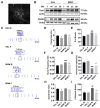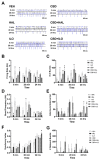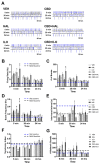Sex-Specific Cannabidiol- and Iloperidone-Induced Neuronal Activity Changes in an In Vitro MAM Model System of Schizophrenia
- PMID: 34073710
- PMCID: PMC8197248
- DOI: 10.3390/ijms22115511
Sex-Specific Cannabidiol- and Iloperidone-Induced Neuronal Activity Changes in an In Vitro MAM Model System of Schizophrenia
Abstract
Cortical circuit dysfunction is thought to be an underlying mechanism of schizophrenia (SZ) pathophysiology with normalization of aberrant circuit activity proposed as a biomarker for antipsychotic efficacy. Cannabidiol (CBD) shows potential as an adjunctive antipsychotic therapy; however, potential sex effects in these drug interactions remain unknown. In the present study, we sought to elucidate sex effects of CBD coadministration with the atypical antipsychotic iloperidone (ILO) on the activity of primary cortical neuron cultures derived from the rat methylazoxymethanol acetate (MAM) model used for the study of SZ. Spontaneous network activity measurements were obtained using a multielectrode array at baseline and following administration of CBD or ILO alone, or combined. At baseline, MAM male neurons displayed increased bursting activity whereas MAM female neurons exhibited no difference in bursting activity compared to sex-matched controls. CBD administered alone showed a rapid but transient increase in neuronal activity in the MAM networks, an effect more pronounced in females. Furthermore, ILO had an additive effect on CBD-induced elevations in activity in the MAM male neurons. In the MAM female neurons, CBD or ILO administration resulted in time-dependent elevations in neuronal activity, but the short-term CBD-induced increases in activity were lost when CBD and ILO were combined. Our findings indicate that CBD induces rapid increases in cortical neuronal activity, with sex-specific drug interactions upon ILO coadministration. This suggests that sex should be a consideration when implementing adjunct therapy for treatment of SZ.
Keywords: cannabidiol; electrophysiology; haloperidol; iloperidone; primary cortical neurons; schizophrenia.
Conflict of interest statement
The authors declare no conflict of interest.
Figures





Similar articles
-
Altered dopamine D3 receptor gene expression in MAM model of schizophrenia is reversed by peripubertal cannabidiol treatment.Biochem Pharmacol. 2020 Jul;177:114004. doi: 10.1016/j.bcp.2020.114004. Epub 2020 Apr 28. Biochem Pharmacol. 2020. PMID: 32360362
-
Cannabidiol Counteracts Amphetamine-Induced Neuronal and Behavioral Sensitization of the Mesolimbic Dopamine Pathway through a Novel mTOR/p70S6 Kinase Signaling Pathway.J Neurosci. 2016 May 4;36(18):5160-9. doi: 10.1523/JNEUROSCI.3387-15.2016. J Neurosci. 2016. PMID: 27147666 Free PMC article.
-
Cannabidiol Improves Cognitive Impairment and Reverses Cortical Transcriptional Changes Induced by Ketamine, in Schizophrenia-Like Model in Rats.Mol Neurobiol. 2020 Mar;57(3):1733-1747. doi: 10.1007/s12035-019-01831-2. Epub 2019 Dec 11. Mol Neurobiol. 2020. PMID: 31823199
-
Iloperidone: A new drug for the treatment of schizophrenia.Am J Health Syst Pharm. 2011 Feb 15;68(4):301-8. doi: 10.2146/ajhp100079. Am J Health Syst Pharm. 2011. PMID: 21289324 Review.
-
Potential antipsychotic properties of central cannabinoid (CB1) receptor antagonists.World J Biol Psychiatry. 2010 Mar;11(2 Pt 2):208-19. doi: 10.3109/15622970801908047. World J Biol Psychiatry. 2010. PMID: 20218784 Review.
Cited by
-
Sex Differences in the Neuropsychiatric Effects and Pharmacokinetics of Cannabidiol: A Scoping Review.Biomolecules. 2022 Oct 12;12(10):1462. doi: 10.3390/biom12101462. Biomolecules. 2022. PMID: 36291671 Free PMC article.
References
-
- American Psychiatric Association . Diagnostic and Statistical Manual of Mental Disorders. 5th ed. American Psychiatric Association; Washington, DC, USA: 2013. Schizophrenia and other psychotic disorders.
-
- Nielsen R.E., Levander S., Kjaersdam Telleus G., Jensen S.O., Ostergaard Christensen T., Leucht S. Second-generation antipsychotic effect on cognition in patients with schizophrenia—A meta-analysis of randomized clinical trials. Acta Psychiatr. Scand. 2015;131:185–196. doi: 10.1111/acps.12374. - DOI - PubMed
-
- Howard C.H., Fiedosewicz H., Patel C., Klegon D.A., Bayog R., Berman I. Treatment response and gender in patients with schizophrenia and schizoaffective disorder. Schizophr. Res. 2001;49:232.
MeSH terms
Substances
Grants and funding
LinkOut - more resources
Full Text Sources
Medical

